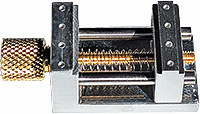
Technical Information Note
Selecting a Vacuum Pump for an SEM Sputter Coater
Introduction
Standard desktop SEM sputter coaters are widely used for coating surfaces of non-conductive samples with a thin layer of precious metal. This will reduce or eliminate charging and improve imaging quality. Precious metals used are Gold, Gold/Palladium, Platinum or Platinum/Palladium. This Technical Information Note provides background information on how to select a vacuum pump for a standard SEM sputter coater.
Pumping specifications needed
Standard desktop SEM sputter coaters use Argon to generate a plasma for the sputtering process. Most sputter coaters work with an Argon operating pressure in the range from 0.2 to 0.02mbar. The volume of the chambers is usually only a couple of liters. With these requirements the ultimate vacuum of the vacuum pump needs to be in the region of 0.001 mbar (1 x 10-3mbar) with a pumping capacity of 3-6m3/h (50-100 l/min). See note 1.
Type of vacuum pump
For the medium vacuum range there are a number of pumps available:
- Diaphragm pumps (not suitable)
- Dry Scroll Pumps (not suitable)
- Single stage rotary pump (not suitable)
- Dual stage rotary pump (only choice for sputter coaters)
Diaphragm pumps
Diaphragm pumps tend to have a low pumping capacity but the main problem is a relatively low ultimate vacuum. The better ones only go to down to the 1 mbar range; clearly not enough for an SEM desktop sputter coater.
Dry Scroll pumps
Dry Scroll pumps have excellent pumping capacity specifications, but the ultimate vacuum is in the 0.05mbar range which is simply not enough for a sputter coater.
Single stage rotary pumps
Single stage rotary pumps are available with the correct pumping capacity specifications, but the ultimate vacuum is in the 0.01mbar range which is not enough for a sputter coater.
Dual stage rotary pumps
Dual stage rotary pumps supply the correct pumping capacity and an ultimate vacuum in the 10-3 to 10-4 mbar range; ideal for sputter coating applications.
Conclusion
Although both diaphragm pumps and scroll pumps have the advantage of being dry pumps without the need to use vacuum pumping oil, they are not suitable for standard SEM desktop sputter coaters. Dual stage rotary vacuum pumps provide the pumping capacity and end-vacuum needed.
Note 1: Pumping speed and ultimate vacuum.
The pumping speed for vacuum pumps in the medium vacuum range is specified at atmospheric pressure. When vacuum increases, pumping speed decreases to practically zero at ultimate vacuum. Therefore the ultimate vacuum of a pump needs to a magnitude better than the operating pressure.
Note 2: Oil vapor back-streaming concerns.
With oil filled dual stage rotary pumps there can be concerns about oil vapor back-streaming. Back-streaming generally occurs when there is equilibrium in the vacuum system with virtually no gas flow into the rotary pump. If the pumping cycles remain short and the sample is removed shortly after coating, back-streaming does not occur.
Note 3: Vacuum requirements for FE-SEM sputter coaters
High resolution desktop FE-SEM sputter coating systems need a base vacuum in the 10-6 mbar range. This is generated by a turbo pump and a backing pump. Using dry scroll pumps or diaphragm pumps as backing pumps can be a suitable alternative for dual stage rotary pumps.
Note 4: Using air as process gas instead of Argon
If air is used as process gas instead of Argon, the ultimate vacuum of the vacuum pump can be in the 10-2 to 10-3mbar range. Air as process gas can only be used with a Gold target and only use for low and medium resolution applications or for table top SEMs.
Note 5: Vacuum pump power connection.
The vacuum pump for small desktop coaters is usually connection to the coater and activated by the power switch of the coater. This requires that the power rating of the pump is compatible with the power rating of the power outlet of the coater. Most pumps up to 8m3/h should be compatible. Larger pumps are incompatible due to the higher power rating.




